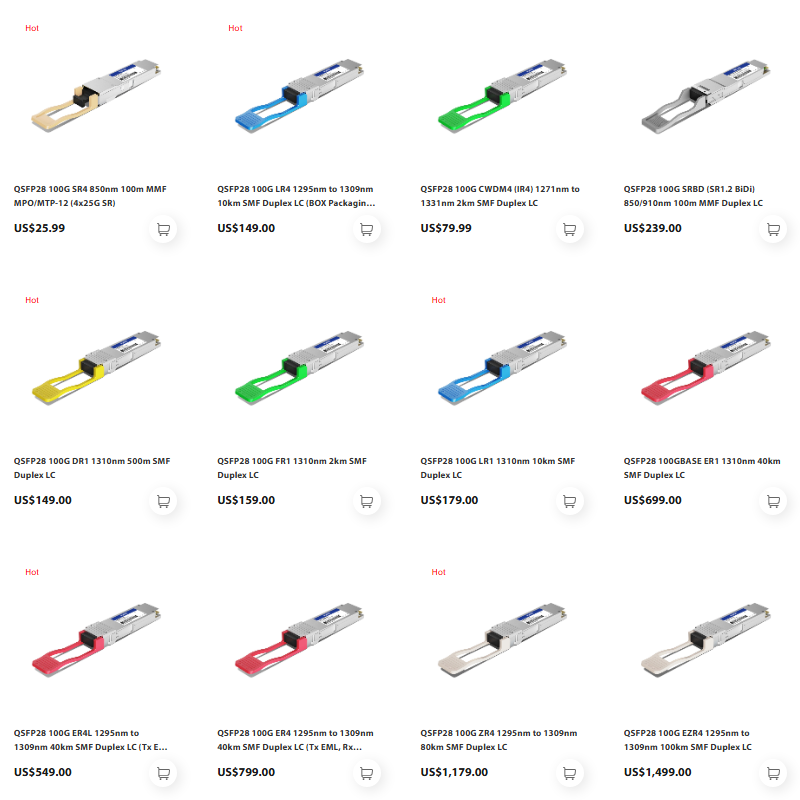QSFP28 100G Transceiver Comprehensive Comparison
By Tim (CCIE#41594)
November 3rd, 2025
19 views
Introduction:In the world of high-speed networking, the QSFP28 100G transceiver has become a cornerstone for data centers, telecommunications networks, and enterprise infrastructure. Offering a significant leap in data rates over previous generations, QSFP28 modules are essential for applications that demand ultra-fast, high-capacity connectivity. Whether you are upgrading your network or building a new one, choosing the right QSFP28 transceiver can make all the difference in performance, scalability, and reliability.

How to Choose the Right Transceiver?
The QSFP28 100G transceiver series offers a wide variety of models, each playing a vital role in different application scenarios through its unique technical features. Below is a detailed comparison to help you choose the model best suited to your needs:
In the comparison chart, we can see that some models have almost identical functions, such as QSFP28 100G SRBD (SR1.2) and QSFP28 100G SWDM4, QSFP28 100G ER4 Lite (4WDM-40) and QSFP28 100G ER4. What are the differences between them? We will explain the differences in detail below.
QSFP28 100G SRBD (SR1.2) VS. QSFP28 100G SWDM4
Traditional 100G SR4 transceivers use MTP/MPO-12 connectors, which are incompatible with the patch cords used in 10G/25G multi-mode transceivers. Upgrading from 10G/25G to 100G requires rewiring, significantly increasing workload and deployment costs.
The QSFP28 100G SRBD (SR1.2) and QSFP28 100G SWDM4 were developed to solve this problem. Both employ "multi-mode" and "Duplex LC" technologies. This allows for upgrades from 10G/25G to 100G by simply replacing the transceivers at both ends of the line, eliminating the need for rewiring and saving considerable labor costs.
Both the QSFP28 100G SRBD (SR1.2) and QSFP28 100G SWDM4 use the QSFP28 package and feature 4 x 25G electrical interfaces.
The difference lies in the optical interface:
SRBD uses 2x50G PAM4 optical signals, transmitting 50G BiDi optical signals on each multi-mode fiber, totaling 100G in both directions.
SWDM4 uses 4x25G NRZ optical signals, transmitting unidirectional 100G optical signals on each fiber, with one fiber for transmission and one for reception.
The third option for "multi-mode" and "Duplex LC" technologies is LX4. The difference between LX4 and SWDM4 is that LX4 uses CWDM4 wavelengths and can simultaneously support single-mode and multi-mode fiber transmission, up to 100m (multi-mode) and 2km (single-mode).
INPHE provides 100G solutions for all three of these "multi-mode" and "Duplex LC" technologies.
QSFP28 100G ER4 Lite (4WDM-40) VS. QSFP28 100G ER4
Both QSFP28 100G ER4 Lite (4WDM-40) and QSFP28 100G ER4 have a working distance of 40km. The difference lies in whether FEC transmission is used for 40km.
The QSFP28 100G ER4 Lite (4WDM-40) requires RS FEC to be enabled on the host platform (switch or router) in order to transmit 40km.
The QSFP28 100G ER4 can transmit 40km without enabling RS FEC on the host platform (switch or router).
The fundamental reason for this gap lies in the receiving sensitivity. Both models use EML transmitters. The QSFP28 100G ER4 Lite (4WDM-40) uses APD receivers, while the QSFP28 100G ER4 uses SOA+PIN receivers.
In addition, there is another type of ER4 Lite that uses a DML transmitter and an APD receiver. This ER4 Lite does not comply with the MSA standard, and INPHE does not provide this downgraded type of ER4 Lite.
The above is a brief introduction to various models of the QSFP28 100G transceiver. INPHE offers a wide range of QSFP28 100G transceivers.
Thank you for reading.
Previous
QSFP28 100G BiDi Simplex LC Optics
Read More
